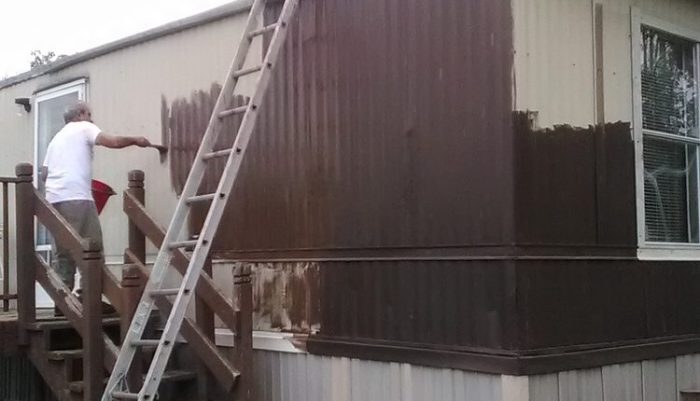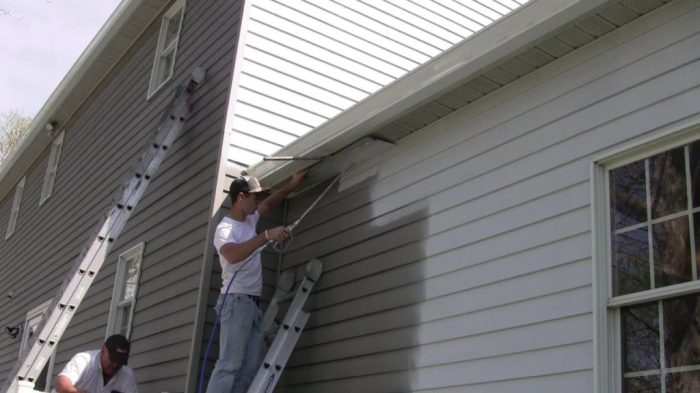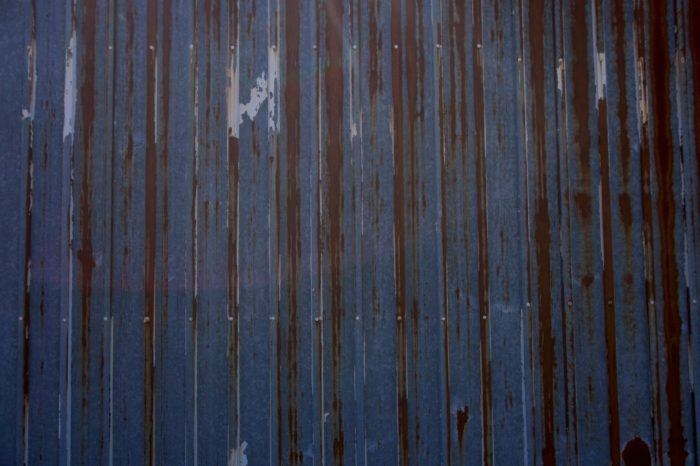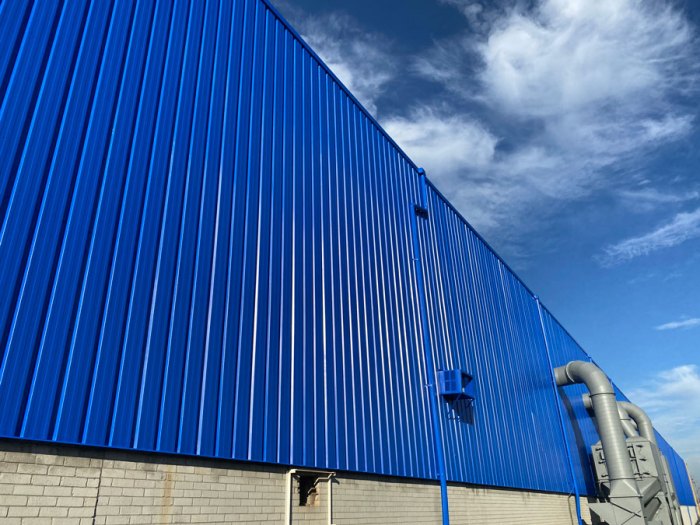Best Paint for Steel Siding A Complete Guide

Best paint for steel siding? It’s more than just picking a color; it’s about choosing the right paint type for long-lasting protection and a beautiful finish. This guide dives into the specifics, from understanding the properties of different paints like acrylic, alkyd, epoxy, and polyurethane, to mastering surface preparation and application techniques. We’ll cover everything you need to know to achieve a professional-looking paint job that will stand the test of time.
Choosing the right paint is crucial for protecting your steel siding from the elements and maintaining its aesthetic appeal. This guide will walk you through selecting the ideal paint type, preparing the surface properly, choosing the right color, and applying it correctly. We’ll also explore cost considerations and maintenance tips to ensure your steel siding remains in top condition for years to come.
Types of Paint for Steel Siding
Choosing the right paint for your steel siding is crucial for long-lasting protection and aesthetic appeal. The type of paint you select will significantly impact the durability, appearance, and overall lifespan of your siding. Several factors, including climate, budget, and desired finish, should be considered when making your decision.
Paint Types Suitable for Steel Siding
Selecting the appropriate paint for steel siding involves understanding the properties of different paint types. Each offers a unique combination of durability, application ease, and aesthetic qualities. The following table summarizes key characteristics of common choices.
| Paint Type | Key Features | Durability | Application Method |
|---|---|---|---|
| Acrylic | Water-based, low odor, fast drying, good adhesion, flexible, mildew resistant | Good to excellent, depending on quality and number of coats | Brush, roller, sprayer |
| Alkyd (Oil-Based) | Excellent adhesion, durable, water-resistant, smooth finish, self-leveling | Excellent, longer lasting than acrylics, good for harsh climates | Brush, roller, sprayer |
| Epoxy | High durability, excellent chemical resistance, strong adhesion, resists chipping and peeling. | Excellent, very long-lasting, ideal for high-traffic or harsh environments | Brush, roller, sprayer |
| Polyurethane | Extremely durable, weather-resistant, UV resistant, hard finish, excellent gloss retention | Excellent, very long-lasting, ideal for high-performance applications | Brush, roller, sprayer |
Acrylic Paint Properties and Suitability
Acrylic paints are water-based, making them relatively easy to clean up with soap and water. Their low odor is a significant advantage for homeowners sensitive to strong paint fumes. They offer good adhesion to properly prepared steel surfaces and are flexible enough to withstand some expansion and contraction of the siding due to temperature changes. However, acrylics may not be as durable as alkyd or epoxy paints in extremely harsh weather conditions, requiring more frequent repainting. Their durability can be enhanced by using a high-quality primer specifically designed for steel surfaces before application.
Alkyd Paint Properties and Suitability, Best paint for steel siding
Alkyd paints, also known as oil-based paints, offer superior durability and water resistance compared to acrylics. They form a hard, protective layer that effectively shields the steel siding from the elements. Their self-leveling properties contribute to a smooth, even finish. Alkyd paints typically provide a longer lifespan than acrylic paints, making them a cost-effective option in the long run, especially in areas with harsh weather. However, alkyd paints have a strong odor during application and require solvents for cleanup, making them less convenient than water-based acrylics.
Epoxy Paint Properties and Suitability
Epoxy paints are known for their exceptional durability and chemical resistance. They form a very tough, protective coating that is highly resistant to chipping, peeling, and corrosion. This makes them an excellent choice for steel siding in industrial or high-traffic areas where the surface might be subjected to significant wear and tear. Epoxy paints generally offer the longest lifespan among the common paint types for steel siding. However, epoxy paints can be more challenging to apply and require careful preparation of the surface for optimal adhesion.
Polyurethane Paint Properties and Suitability
Polyurethane paints provide an extremely durable and hard-wearing finish. Their high UV resistance helps prevent fading and color degradation over time, maintaining the appearance of the siding for extended periods. Polyurethane paints are ideal for areas with intense sunlight or harsh weather conditions where long-lasting protection is paramount. However, they can be more expensive than other paint types and may require specialized application techniques to achieve a smooth, even finish. Their high gloss retention can also be a factor for homeowners who prefer a more matte finish.
Surface Preparation for Steel Siding

Source: mobilehomeliving.org
Proper surface preparation is crucial for a long-lasting and attractive paint job on your steel siding. Failing to adequately prepare the surface will result in poor paint adhesion, premature peeling, and a generally unsatisfactory finish. This section details the necessary steps to ensure your paint adheres properly and provides years of protection.
The success of your painting project hinges on meticulous preparation. Think of it as building a strong foundation for your house – if the foundation is weak, the whole structure will suffer. Similarly, if your steel siding isn’t properly cleaned and primed, the paint won’t bond effectively, leading to early failure.
Steel Siding Cleaning and Degreasing
Before applying any paint, your steel siding needs a thorough cleaning to remove dirt, grime, mildew, and any other contaminants that could interfere with paint adhesion. This process involves several key steps, ensuring a clean surface ready for priming and painting.
- Remove Loose Paint and Debris: Start by scraping off any loose, flaking paint using a putty knife or paint scraper. Be gentle to avoid scratching the underlying steel. Use a wire brush to remove any stubborn rust or loose paint particles.
- Pressure Washing: Use a pressure washer with a low-pressure nozzle (around 1500-2500 PSI) to remove dirt, mildew, and other loose contaminants. Keep the nozzle moving constantly to prevent damage to the siding. Work from the bottom up to allow water to run off.
- Degreasing: After pressure washing, allow the siding to dry completely. Then, apply a degreaser according to the manufacturer’s instructions. This removes any oil, grease, or other contaminants that might prevent the primer from adhering properly. Use a scrub brush to work the degreaser into the surface and rinse thoroughly with clean water. Allow the siding to dry completely again before priming.
Visual Representation of Surface Preparation
Imagine a three-panel illustration. The first panel shows steel siding covered in dirt, mildew, and loose paint. This panel represents the initial state before any cleaning begins. Arrows point to the various contaminants. The second panel depicts the siding after pressure washing and scraping; it’s visibly cleaner, but still has some minor imperfections. The third panel shows the perfectly clean, dry steel siding ready for primer application, gleaming and free from contaminants. Each panel illustrates a stage of the preparation process, showcasing the transformation from a dirty, unprepared surface to one ready for paint.
Priming the Steel Siding
Priming is a critical step that ensures the paint adheres properly and lasts longer. Primer acts as a bonding agent between the steel and the topcoat, providing a uniform surface for the paint to adhere to and preventing rust.
Choose a high-quality primer specifically designed for steel. Apply the primer evenly using a roller or brush, following the manufacturer’s instructions. Ensure complete coverage to prevent rust and promote superior paint adhesion. Allow the primer to dry completely before applying the topcoat. Properly primed steel siding will significantly extend the lifespan of your paint job.
Color Selection and Aesthetics
Choosing the right color for your steel siding is a crucial step in achieving the desired look for your home. The color you select significantly impacts the overall curb appeal and can even influence the perceived value of your property. Consider factors like your home’s architectural style, the surrounding landscape, and your personal preferences to make an informed decision.
Popular color choices for steel siding are diverse and depend heavily on the context of your home and environment. Light colors reflect more sunlight, keeping your home cooler in warmer climates, while darker colors absorb more heat and might be preferable in colder regions. However, personal preference should always play a significant role in your final decision.
Examples of Popular Steel Siding Colors
The following bullet points illustrate some popular color choices, keeping in mind the interplay between climate, architectural style, and personal taste. Remember that these are just examples, and the best choice will be specific to your individual needs.
- Neutral Tones (e.g., greys, beiges, whites): These colors are versatile and timeless, complementing various architectural styles. They work well in most climates and provide a clean, classic look. Light neutrals reflect heat in warmer climates, while darker neutrals can provide a more substantial feel in colder areas.
- Deep Blues and Greens: These evoke a sense of tranquility and often work well with natural surroundings. They can be particularly striking against a backdrop of lush greenery. Darker shades may absorb more heat in sunny climates.
- Earthy Tones (e.g., browns, tans): These colors blend seamlessly with natural landscapes and create a warm, inviting feel. They are often chosen for homes in rural or wooded settings.
- Reds and Browns (Darker shades): These colors can create a bold statement and are well-suited for homes with a traditional or rustic style. They can absorb more heat, making them potentially less ideal in hot climates.
Impact of Color on Home Appearance
The color of your steel siding dramatically affects the overall aesthetic and curb appeal of your home. A well-chosen color can enhance architectural details, create a sense of harmony with the surrounding environment, and significantly improve the property’s visual appeal. Conversely, a poorly chosen color can make a home look dated or clash with its surroundings. Consider the following:
- Light colors make a home appear larger and brighter, ideal for smaller homes or those in shaded areas.
- Dark colors can create a sense of sophistication and drama, but they might make a home feel smaller in certain contexts.
- Warm colors (reds, oranges, yellows) tend to create a welcoming and inviting atmosphere.
- Cool colors (blues, greens, purples) often project a sense of calmness and tranquility.
Color Palettes for a Modern Look
Let’s say a client wants a modern look for their home. Here are three color palettes that could achieve this aesthetic:
- Palette 1: Cool Minimalism – A base of cool grey steel siding (think a light, almost silver-toned grey), accented with charcoal grey trim and crisp white window frames. This palette is clean, sophisticated, and emphasizes simplicity. Imagine a sleek, contemporary home nestled amongst modern landscaping.
- Palette 2: Earthy Modern – A warm, mid-toned taupe steel siding provides a neutral foundation. This is paired with darker brown trim and pops of natural wood accents (e.g., a wooden front door). This palette offers a modern feel while still grounding the home in natural elements, creating a sense of calm sophistication.
- Palette 3: Bold Geometric – A deep navy blue steel siding forms the dramatic backdrop. This is offset by bright white trim and perhaps a vibrant accent color like a sunny yellow or a bright coral on the front door. This palette is ideal for those who want to make a statement and is best suited for homes with strong geometric architectural features.
Application Methods and Techniques: Best Paint For Steel Siding

Source: deckerdecks.com
Choosing the right painting method for your steel siding is crucial for achieving a professional-looking, long-lasting finish. Different methods offer varying levels of efficiency, coverage, and ease of use, so understanding the pros and cons of each is key to a successful paint job. Let’s explore the most common options: brush, roller, and spray application.
Comparison of Painting Methods for Steel Siding
The following table summarizes the advantages and disadvantages of each painting method, helping you determine the best approach for your project.
| Method | Advantages | Disadvantages | Suitability for Large/Small Areas |
|---|---|---|---|
| Brush | Excellent control, ideal for detailed work and hard-to-reach areas, good for smaller projects, allows for even coat application in tight spaces. | Labor-intensive, time-consuming, can leave brush strokes visible if not properly blended, less efficient for large surfaces. | Small to medium areas |
| Roller | Faster than brushing, provides good coverage, relatively easy to use, suitable for larger, flat surfaces. | May not reach into crevices or corners easily, can leave roller marks if not applied correctly, requires a good quality roller cover for a smooth finish. | Medium to large areas |
| Spray Application (Airless Sprayer) | Fastest method, provides excellent coverage, ideal for large surfaces, produces a very smooth finish. | Requires specialized equipment, can be messy if not used properly, may require more preparation to prevent overspray, potential for runs and sags if not applied correctly, more expensive initial investment. | Large areas |
Tools and Equipment for Each Application Method
Proper tools are essential for a professional finish regardless of the method chosen.
Brush Application: You’ll need high-quality brushes designed for exterior use. Angled sash brushes are great for reaching corners and edges, while wider brushes are efficient for larger areas. A paint tray and a good quality paint can opener are also essential.
Roller Application: A sturdy roller frame with an extension handle (for reaching high areas) is recommended. Choose a roller cover appropriate for the paint type (e.g., a lambswool roller for smooth surfaces, a thicker nap roller for textured surfaces). You’ll also need a roller tray and a paint can opener.
Spray Application: An airless sprayer is necessary. This involves a significant investment, but is highly efficient for large projects. You’ll also need appropriate safety gear, including a respirator mask, eye protection, and protective clothing to prevent overspray. Cleaning supplies for the sprayer are also essential.
Proper Techniques for Each Application Method
Consistent application is key to a professional finish.
Brush Application: Apply the paint in thin, even coats, working in the direction of the siding. Overlap each stroke slightly to avoid streaks. Allow each coat to dry completely before applying the next. For best results, use a “W” pattern to ensure even coverage and minimize brush strokes.
Roller Application: Load the roller with paint, avoiding oversaturation. Apply the paint in smooth, even strokes, working in sections. Overlap each stroke slightly to avoid streaks. Use a back-and-forth motion, keeping the roller in contact with the surface to maintain an even coat. Allow each coat to dry completely before applying the next.
Spray Application: Maintain a consistent distance from the surface (typically 12-18 inches). Overlap each pass slightly to ensure complete coverage. Use slow, even movements, avoiding lingering in one area to prevent runs and sags. Clean the sprayer thoroughly after use according to the manufacturer’s instructions. Remember to always follow safety precautions when using spray equipment.
Maintenance and Longevity

Source: rpsmetalroofing.com
Keeping your freshly painted steel siding looking its best and extending its lifespan requires a bit of proactive care. Regular maintenance not only enhances the aesthetic appeal but also protects your investment by preventing premature deterioration and costly repairs. This section details how to maintain your paint job and the factors influencing its longevity.
Proper maintenance significantly impacts how long your paint job lasts. Neglect can lead to faster fading, chipping, and rust, shortening the life of your siding considerably. Understanding the factors affecting paint longevity allows you to make informed choices about paint selection and maintenance practices.
Maintaining Painted Steel Siding
A simple cleaning and occasional touch-ups go a long way in preserving your steel siding’s painted finish. The following guidelines will help you keep your siding looking great for years to come.
- Regular Cleaning: Wash your siding at least once or twice a year, preferably in spring and fall. Use a soft-bristled brush, a garden hose, and a mild detergent solution. Avoid harsh chemicals or high-pressure washers, which can damage the paint.
- Inspect for Damage: During cleaning, carefully inspect the siding for any signs of damage, such as chips, cracks, or peeling paint. Address these issues promptly with touch-ups to prevent further deterioration.
- Touch-Up Procedures: Use a high-quality exterior paint that matches your original color. Before applying the touch-up paint, lightly sand the damaged area to create a better surface for adhesion. Apply thin coats to avoid drips and allow each coat to dry completely before applying the next.
- Mold and Mildew Removal: If mold or mildew appears, clean the affected areas with a solution of bleach and water (follow product instructions carefully). Always rinse thoroughly after cleaning.
Factors Affecting Paint Longevity
Several factors influence how long your paint job will last. Understanding these factors helps you make informed decisions and take appropriate preventative measures.
- Weather Conditions: Harsh weather, including intense sun, freezing temperatures, and heavy rainfall, accelerates paint degradation. Coastal areas with salt spray experience even faster deterioration. Choosing a paint specifically formulated for extreme weather conditions is crucial.
- Paint Quality: High-quality, exterior-grade paints with good UV protection and excellent adhesion properties will last significantly longer than cheaper alternatives. Look for paints with a long warranty for added assurance.
- Surface Preparation: Proper surface preparation is paramount. Thorough cleaning, priming (if necessary), and the correct application techniques directly impact paint adhesion and longevity. Poor preparation leads to premature peeling and chipping.
Expected Lifespan of Paint on Steel Siding
The lifespan of paint on steel siding varies significantly depending on the paint type, quality, and environmental conditions. These are estimates, and actual lifespan may vary.
| Paint Type | Mild Climate (e.g., Southern California) | Moderate Climate (e.g., Mid-Atlantic) | Harsh Climate (e.g., Coastal New England) |
|---|---|---|---|
| High-Quality Acrylic Latex | 10-15 years | 8-12 years | 5-8 years |
| High-Quality Alkyd (Oil-Based) | 12-18 years | 10-15 years | 7-10 years |
| Low-Quality Paints | 5-7 years | 3-5 years | 2-3 years |
Note: These are estimates and actual lifespan can vary depending on factors like application, maintenance, and specific environmental conditions.
Cost Considerations and Budget Planning
Painting steel siding can be a significant investment, but understanding the cost factors involved allows for better budgeting and prevents unexpected expenses. Proper planning ensures a smooth project and a high-quality finish. Let’s break down the costs to help you create a realistic budget.
Cost Breakdown for Painting Steel Siding
Several factors influence the overall cost of painting your steel siding. Accurate estimation requires considering all these elements.
- Paint Costs: The type of paint significantly impacts the price. High-quality exterior paints designed for metal surfaces tend to be more expensive but offer superior durability and longevity. The amount of paint needed depends on the surface area of your siding and the number of coats required. Expect to pay anywhere from $30 to $80 per gallon, depending on the brand and type.
- Materials Costs: Beyond paint, you’ll need brushes, rollers, paint trays, drop cloths, cleaning supplies (like a pressure washer or TSP), and possibly scaffolding or a ladder. These materials can add up, costing anywhere from $100 to $500 depending on the size of the house and the tools you already own.
- Labor Costs: Hiring professional painters is often the most expensive part of the project. Labor costs vary depending on your location, the size of your house, and the painter’s experience. Expect to pay anywhere from $2 to $6 per square foot, potentially more for complex projects or intricate details.
- Equipment Rental Costs: If you’re not renting equipment, such as a pressure washer or scaffolding, this will reduce the costs significantly. However, renting these tools can be necessary for larger projects or if you lack the necessary equipment, adding another $50 to $200 to your budget.
Sample Budget for Painting Steel Siding
Let’s consider a hypothetical house with 1500 square feet of steel siding.
| Cost Item | Estimated Cost |
|---|---|
| Paint (20 gallons at $50/gallon) | $1000 |
| Materials (brushes, rollers, etc.) | $200 |
| Labor (1500 sq ft at $3/sq ft) | $4500 |
| Equipment Rental (pressure washer) | $100 |
| Total Estimated Cost | $6000 |
This is a rough estimate, and the actual cost could vary depending on the factors mentioned earlier. Remember to get multiple quotes from professional painters to compare prices.
Tips for Saving Money
- DIY Approach: If you’re comfortable with painting, doing it yourself can significantly reduce labor costs. However, factor in the time commitment and the potential for mistakes.
- Purchase Paint in Bulk: Buying paint in larger quantities often results in lower per-gallon costs. This is particularly beneficial for larger projects.
- Shop Around for Materials: Compare prices from different hardware stores and paint suppliers to find the best deals on brushes, rollers, and other supplies.
- Plan Your Project Carefully: Proper surface preparation is crucial for a long-lasting paint job. Thorough prep work reduces the need for extra coats of paint, saving you both time and money.
- Choose a Less Expensive Paint: While high-quality paints are durable, opting for a slightly less expensive brand can save money, especially if the project is a small one.
Final Summary

Source: bestpainting.ca
Painting steel siding is a worthwhile investment that significantly enhances your home’s curb appeal and protects it from the elements. By carefully selecting the right paint, preparing the surface meticulously, and employing the correct application techniques, you can achieve a durable and stunning finish. Remember, proper maintenance is key to extending the lifespan of your paint job. With a little planning and effort, you can transform your steel siding into a beautiful and long-lasting feature of your home.
User Queries
Can I paint steel siding myself, or should I hire a professional?
While DIY is possible, especially for smaller areas, professional painters often have the experience and equipment for a smoother, more even finish, particularly on larger surfaces. Consider your skill level and the size of your project.
How long does steel siding paint typically last?
The lifespan varies depending on paint quality, surface preparation, weather conditions, and maintenance. High-quality paints and proper prep can extend the life to 10-15 years or more.
What’s the best time of year to paint steel siding?
Aim for temperatures between 50-85°F (10-29°C) with low humidity. Avoid painting in direct sunlight or when rain is expected.
What if I only need to touch up a small area?
Use the same type of paint as the original coating for a seamless match. Clean the area thoroughly before applying a small amount of paint.
Are there environmentally friendly options for steel siding paint?
Yes, many manufacturers offer low-VOC (volatile organic compound) paints that are less harmful to the environment and your health. Look for certifications like Green Seal.
Comments are closed.